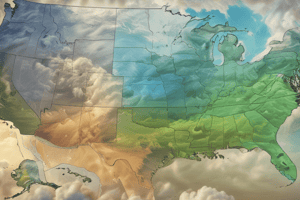Podcast
Questions and Answers
What temperature range is clear ice typically found in Cumulus clouds?
What temperature range is clear ice typically found in Cumulus clouds?
- 0 to -25°C (correct)
- -10 to -30°C
- 0 to -15°C
- -20 to -40°C
What should a pilot do in the event of a communication failure while in controlled Class B airspace?
What should a pilot do in the event of a communication failure while in controlled Class B airspace?
- Continue to communicate on the last known frequency
- Leave controlled Class B airspace and squawk 7600 (correct)
- Declare an emergency and land immediately
- Attempt to re-establish communication without leaving airspace
What is the ISA deviation at an altitude of FL280 where the temperature is -48°C?
What is the ISA deviation at an altitude of FL280 where the temperature is -48°C?
- ISA-10
- ISA-5
- ISA-8 (correct)
- ISA-3
What is the typical range of a VOR (VHF Omnidirectional Range) signal?
What is the typical range of a VOR (VHF Omnidirectional Range) signal?
Where is the jet stream or Low-Level Jet (LLJ) most likely to occur?
Where is the jet stream or Low-Level Jet (LLJ) most likely to occur?
What is the main function of an autopilot system in aircraft?
What is the main function of an autopilot system in aircraft?
Where is frontal fog most likely to occur?
Where is frontal fog most likely to occur?
What type of information does the LWIS (Limited Weather Information System) provide?
What type of information does the LWIS (Limited Weather Information System) provide?
Flashcards are hidden until you start studying
Study Notes
Air Masses in North America
- Summer Air Masses: Primarily Maritime Tropical (MT), with rare occurrences of Continental Arctic (CA) and Maritime Polar (MP).
- Winter Air Masses: Continental Arctic (CA), Maritime Polar (MP), and Maritime Tropical (MA) can be present.
- April Air Mass Movement: Maritime Tropical (MT) air mass typically enters from the USA during April.
Weather Phenomena
- Virga: Precipitation that evaporates before reaching the ground leads to dry microbursts.
Wind Types
- Daytime Slope and Valley Winds: Characterized as anabatic winds, which occur due to adiabatic heating.
ACAS II Capabilities
- Provides resolution advisory (RA) similar to TCAS II, assisting in maintaining safe separation between aircraft.
Ice Formation
- Clear Ice Temperature Range: Found in cumulus clouds, typically from 0°C to -25°C.
Communication Failure Procedures
- Pilots must exit controlled Class B airspace and squawk transponder code 7600 to indicate communication failure.
Temperature and Pressure Calculations
- Temperature at FL280: Recorded at -48°C, equating to an ISA deviation of -8.
VOR Distance Range
- VOR (VHF Omnidirectional Range) maximum operating distance is approximately 50 nautical miles, with a minimum altitude of 1,500 feet.
Jet Stream Occurrences
- Jet streams or Low-Level Jets (LLJ) primarily occur between polar and tropical air masses.
Autopilot Functions
- Autopilot changes the aircraft’s center of gravity (CG) and its movement to maintain desired flight parameters.
Frontal Fog Locations
- Frontal fog is likely to occur ahead of cold fronts and behind cold fronts, with occurrences ahead of warm fronts being incorrect.
LWIS Information
- The automated Limited Weather Information System (LWIS) provides essential weather updates relevant to flight operations.
Studying That Suits You
Use AI to generate personalized quizzes and flashcards to suit your learning preferences.




